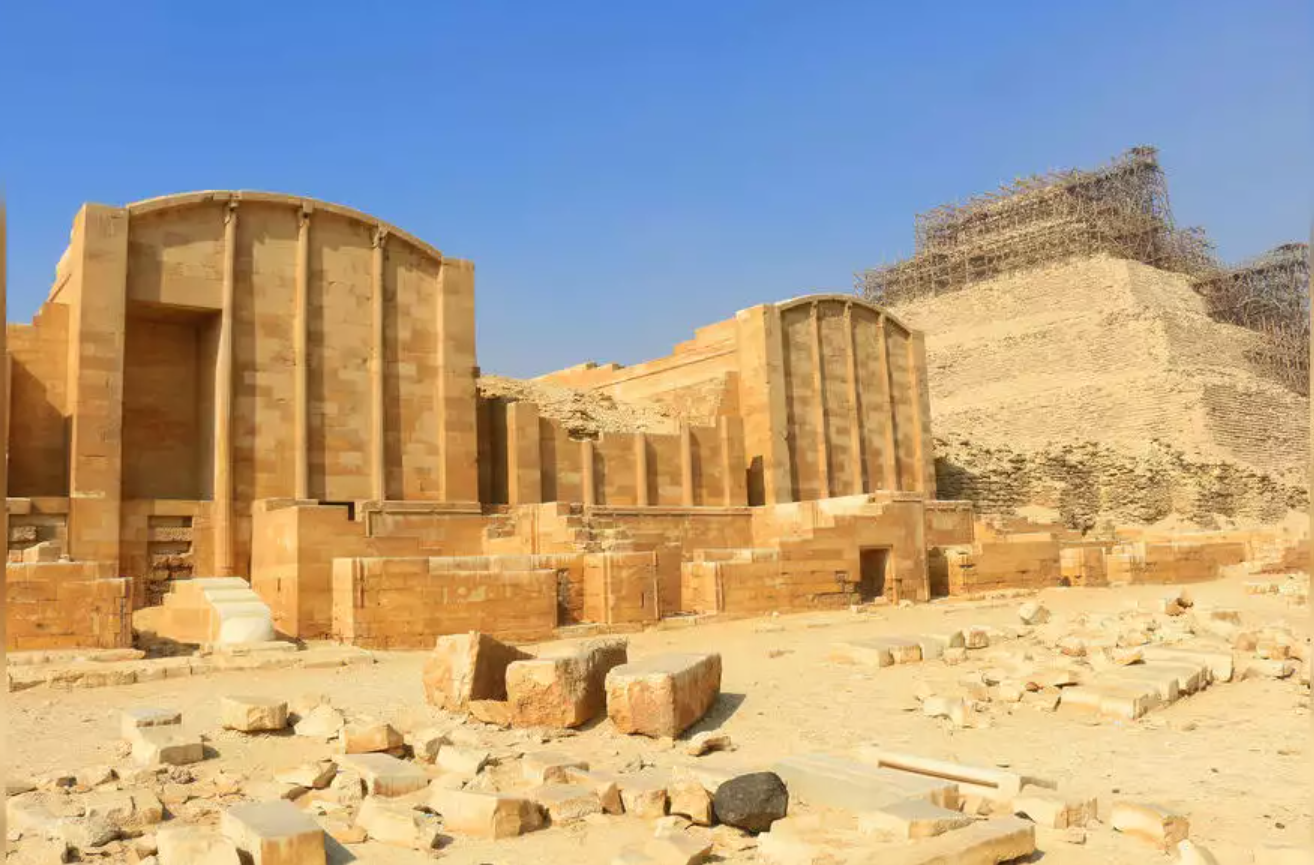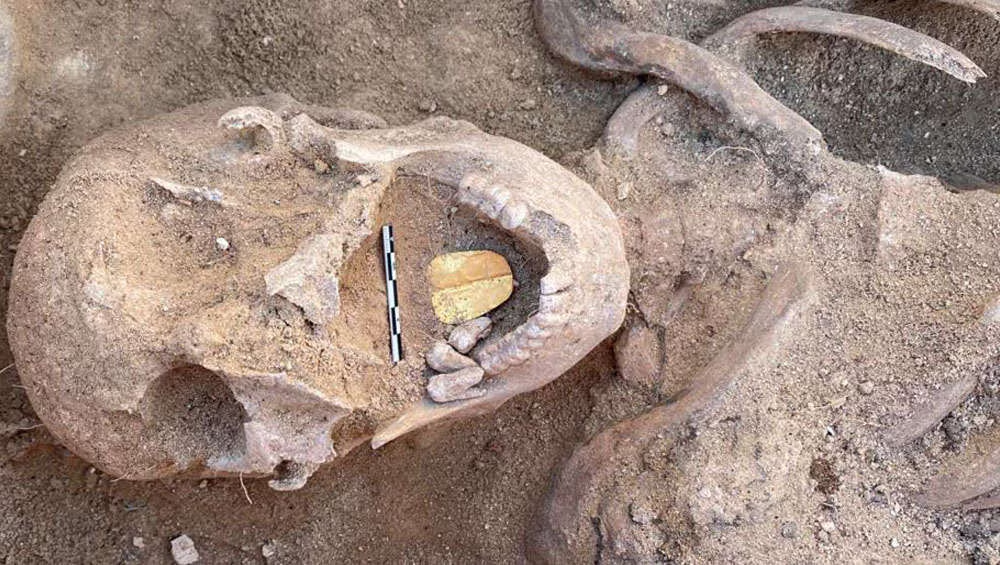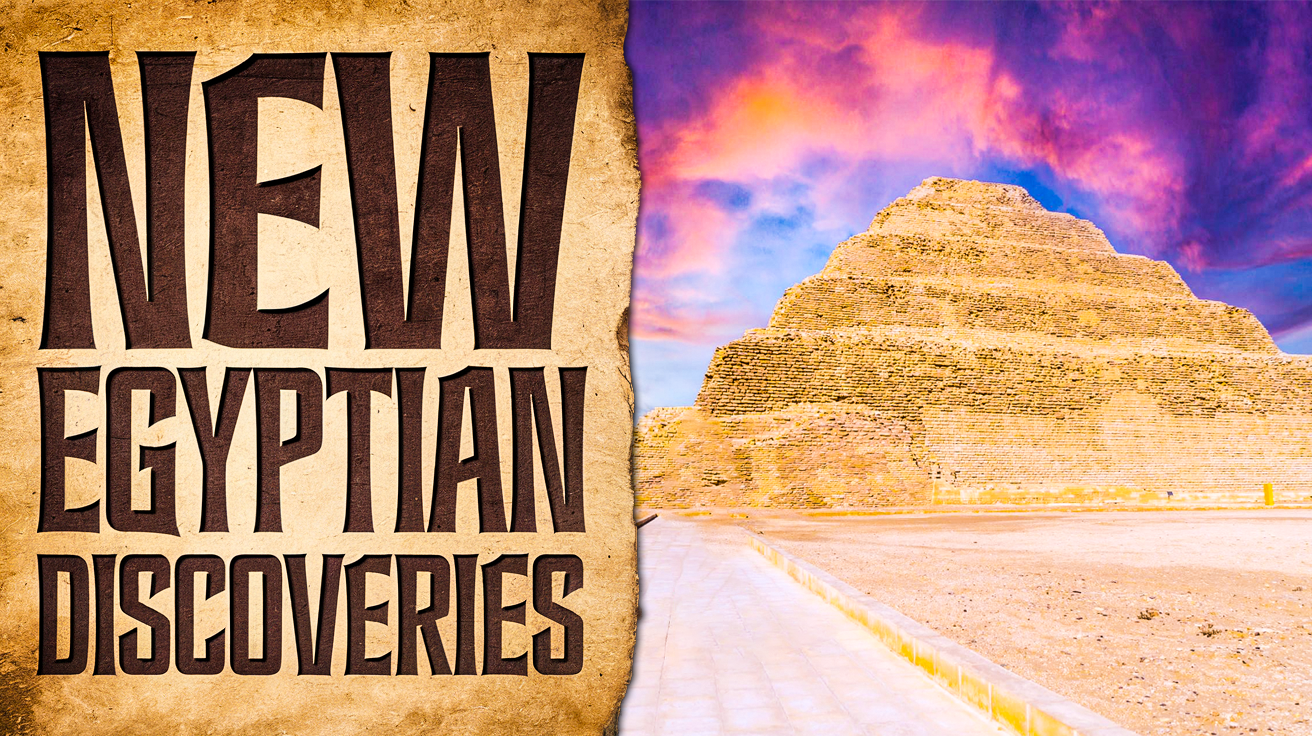In the shadow of towering pyramids and along the banks of the timeless Nile, Egypt’s ancient past continues to whisper its secrets to those who listen. Recent archaeological endeavors have led to the unearthing of peculiar and extraordinary finds, adding still more layers to the tapestry of Egypt’s rich history. Beneath the well-known marvels and famous dig sites, more discoveries are unearthed and beckon us deeper into the incredible time of the pharaohs. From the discovery of protective childbirth tattoos to the unearthing of a sprawling pit complete with a golden mummy, these are the 14 strangest and most exciting things recently discovered in Egypt.
14. The Hidden Chamber In The Great Pyramid

Even at 4,500 years old, the Great Pyramid of Giza is still revealing new secrets. A 2023 study by an international team of researchers from Egypt, France, and Japan unveiled details about a hidden corridor above the pyramid’s main entrance. This sealed-off corridor, measuring 9 meters in length and 2 meters in width, remains a mystery, as archaeologists are unsure of its purpose. One theory suggests it was designed to distribute weight and prevent the pyramid from collapsing. The potential for more hidden mysteries within this iconic structure is tantalizing, as researchers continue to explore what lies beyond.
The Great Pyramid, built around 2560 BCE, stands as the oldest of the Seven Wonders of the Ancient World. Its construction techniques and architectural precision have long fascinated historians and archaeologists alike. The discovery of this hidden corridor adds another layer to our understanding of the pyramid’s design and the ingenuity of its builders.
13. A New Tomb Complex In The Saqqara Necropolis

The Saqqara necropolis has proven to be a treasure trove of information, with a recent discovery of a 3,200-year-old underground tomb complex. A cooperative group of Dutch and Italian archaeologists, working with Egypt’s Supreme Council of Antiquities, identified the occupant of this tomb as Panehsy, a well-known caretaker of the Amon temple during Pharaoh Ramses II’s era. The complex features a freestanding temple with elaborate embellishments, including an impressive entrance and three exquisite chapels.
Inside the tomb, archaeologists encountered striking images of Panehsy and his wife, Baia, performing holy rites. One such image is a stunning stone relief that depicts the couple at an offering table. This discovery not only sheds light on the religious rituals of ancient Egypt but also provides insight into the hierarchical structures of society during that era. The intricate details found within this tomb complex offer a glimpse into the lives and beliefs of those who lived thousands of years ago.
12. The Temple of Zeus-Kasios

Archaeologists have discovered the remains of a Zeus-inspired temple in the Sinai Peninsula. This sacred sanctuary, honoring Zeus-Kasios, represents a fusion of Greek and Egyptian religious practices. The site, nestled on the slopes of Jebel Aqra, is steeped in mythology, having witnessed a legendary battle between Zeus and the monstrous Typhon.
Recent excavations unveiled two met tall pink granite pillars and remnants of an entrance gate, believed to have succumbed to an ancient earthquake. The discovery of granite blocks, thought to be part of a staircase for worshippers, invites us to explore the realms of ancient worship and multiculturalism. This temple’s rediscovery highlights the rich tapestry of beliefs that existed in antiquity, where gods and mountains converged in a sacred dance.
11. The Fayyum Portraits

In a momentous find, archaeologists have uncovered full-color portraits of mummies, the first such discovery in over a century. These remarkable portraits were found at the Giza excavation site in Fayyum, Egypt, an ancient gold mine. The excavation site, surrounded by the ruins of the ancient city of Philadelphia, provides insights into the lifestyles of individuals who lived nearly 2,000 years ago.
The portraits feature the faces of wealthy members of prehistoric societies, showcasing the artistic prowess of ancient craftsmen. This discovery not only enriches our understanding of ancient Egyptian art but also opens the door to further exploration of the lives and identities of those depicted. As researchers continue to study these captivating hues, we are reminded of the enduring legacy of ancient Egyptian culture and its artistic achievements.
10. The Falcon Shrine at Berenike

In the ancient port city of Berenike, Egypt, archaeologists have stumbled upon a 1700-year-old Falcon Shrine that has left them puzzled. This site features headless falcons, enigmatic depictions of unknown gods, and a mysterious inscription declaring it improper to boil a head in the shrine. The discovery of 15 headless falcons raises questions about the rituals and beliefs associated with this ancient site.
Adjacent to the pedestal bearing the remains of the falcons, a stone monument depicting two unknown gods adds to the intrigue. The decapitation of the falcons is interpreted as a local gesture, possibly a live offering to the shrine’s god. The inscription, along with the discovery of an iron harpoon, introduces an element of mystery, leaving archaeologists to ponder the significance of these findings in the context of ancient Egyptian religious practices.
9. The Tunnel Of Taposiris Magna

In the labyrinthine recesses of Taposiris Magna, archaeologists have unearthed a 6.5 ft tall, 4,300 ft long tunnel dedicated to Osiris, the god of death. Concealed approximately 43 feet beneath the temple grounds, this extraordinary discovery showcases the advanced engineering prowess of ancient civilizations. The tunnel, which lies partially submerged underwater, is believed to have been affected by seismic activities that shook the region centuries ago.
The meticulous craftsmanship of the Taposiris Magna tunnel invites further exploration into the secrets hidden beneath the sands of time. Its striking resemblance to the Eupalinos Tunnel in Greece highlights the engineering marvels of antiquity.
8. New Context For Mummification

A forthcoming museum exhibition challenges the long-held belief that ancient Egyptians practiced mummification solely for preservation. The Golden Mummies of Egypt exhibition at the University of Manchester proposes that mummification was a transformative journey toward divinity. This reinterpretation, spearheaded by curator Campbell Price, emphasizes the spiritual dimensions woven into this ancient practice.
The misconception that mummification was akin to preserving fish stems from Victorian researchers’ Western-centric interpretations. The revelation that Natron, a naturally occurring mineral, served as the embalming substance may serve as a challenge to current understanding of ancient Egyptian beliefs.
7. Protective Childbirth Tattoos

Recent archaeological discoveries have revealed that the practice of tattooing dates back over three millennia. The revelation of at least six tattooed women at Deir el-Medina showcases the significance of these tattoos in ancient Egyptian society. Bioarchaeologist Austin, the lead author of the study, highlights the rarity and difficulty of finding preserved skin, making this discovery particularly remarkable.
The tattoos, featuring distinct patterns and imagery linked to ritual purification, shed light on the multifaceted roles of women in ancient Egypt. These protective tattoos, adorned with depictions of bees and bowls, were likely associated with postpartum rituals aimed at safeguarding both mother and child.
6. Matariya Sun Temple

Archaeologists from a collaborative German-Egyptian mission have uncovered fresh revelations at the Matariya Sun Temple in Heliopolis, one of ancient Egypt’s oldest cities. The recent discoveries include remnants of flooring crafted from white ash and structures built with mud brick, offering glimpses into the architectural prowess of the era. Among the finds are quartzite stones from the reign of Horemheb, the final pharaoh of the 18th Dynasty.
The excavation also unveiled sections of limestone flooring and an unidentified royal statue, contributing to a richer understanding of the temple’s historical tapestry. What significance the royal statue has and the meaning of its presence in a temple to the sun god Atum is still being discussed.
5. Embalming Workshops

Emerging from the remnants of an ancient embalming workshop, scientists have unveiled the long-concealed secrets of the substances and mixtures used in the mummification process. Recent molecular analysis of residues found in pots at a site in Saqqara has brought clarity to this age-old mystery. A total of 121 vessels retrieved from the subterranean embalming workshop provide a comprehensive glimpse into the diverse array of materials employed by the ancient Egyptians.
These substances served various purposes, from anointing the deceased’s body to mitigating unpleasant odors and shielding it from decay. Identified ingredients include plant oils, resins, animal fat, and beeswax.
4. Gold Ring Featuring The God Of Fun

In a remarkable find in the ancient city of Akhetaten (the archeological site itself is Tel el-Amarna), archaeologists have uncovered a burial site dating back over 3,300 years that yielded breathtaking gold jewelry. Among the treasures is a ring featuring an engraving of Bas, known as the god of fun.
Various other pieces of jewelry were also discovered in the site, including a necklace, bracelet and another ring (this one was decorated with hieroglyphics.)
3. Whispers Of The Afterlife: Golden Tongues

In the necropolis of Quweisna, archaeologists have unveiled a captivating enigma concealed within the tombs of mummies. These mummies, adorned with golden tongues, reflect the intricate rituals of the afterlife. Buried between 300 BCE and 640 CE, these mummies, despite their poor state of preservation, have become vessels of whispered tales from ancient Egypt.
The meticulous craftsmanship involved in the embalming process included replacing the tongues of the departed with delicate pieces of gold foil. This practice holds significance in the context of Egyptian mythology, where the departed faced judgment before Osiris, the god of the underworld. The golden tongues served a profound purpose, enabling the deceased to articulate their case before the divine court, revealing the intricate beliefs surrounding death and the afterlife in ancient Egyptian culture.
2. Tomb Of An Unknown Queen

This year marks 100 years since the discovery of Tutankhamun’s tomb, and excitement continues in Saqqara. Archaeologists have found nearly 300 coffins from the New Kingdom, including a pyramid commemorating a queen whose identity has remained veiled in history. Each coffin features distinctive depictions from The Book of the Dead, transcending mere burial vessels.
Among the finds is an extraordinary coffin adorned with a solid gold mask of a woman named Neith. Burials from the New Kingdom era were not understood to be common in the site, with most discoveries being Old Kingdom. What this means for further discoveries remains to be seen.
1. Hekashepes: Egypt’s Oldest And Most Complete Golden Mummy

In a groundbreaking discovery, archaeologists have unearthed what is potentially the most ancient and fully preserved mummy ever found in Egypt. Believed to be the remains of an individual named Hekashepes, this mummy dates back to Egypt’s fifth and sixth Dynasty. The beautifully preserved mummy, adorned in layers of gold, was discovered at the base of a 49 ft shaft near the step pyramid at the necropolis of Saqqara.




























